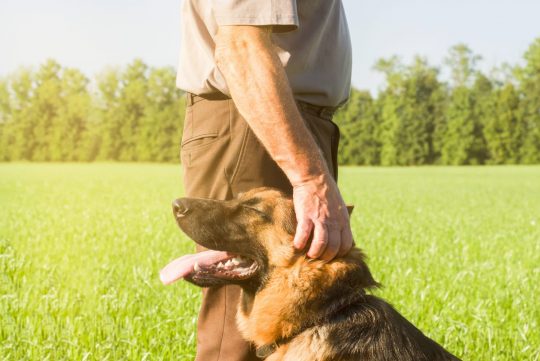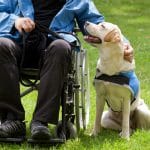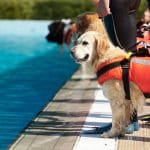Providing Valuable Companionship
There are countless ways how dogs help humans.
Dogs provide therapeutic effects because they fulfill the basic human need for touch. Stroking or hugging your loving pet can calm and soothe during periods of stress and anxiety.
The companionship of a dog eases loneliness and encourages healthy exercise which can boost your mood and ease depression.
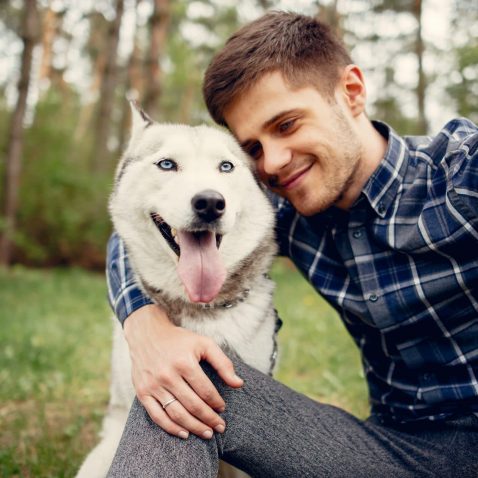
Studies have found that;
- Pet owners have a lower blood pressure than those without pets.
- Pet owners are less likely to suffer from depression than those without pets.
- Retirement age pet owners make percent fewer visits to their doctors than those without.
- Playing with a dog can increase levels of dopamine and serotonin, which allows for calm and relaxation
The saying; “Dog is man’s best friend” maybe a cliché, but it’s accurate!
Increasing Excercise
Taking your dog for a walk, run or hike is an enjoyable way to fit healthy exercise into your daily routine.

How Dogs Help Humans Exercise
Recent studies have proven that dog owners are more likely to meet their daily exercise requirements. Regular exercise is also great for your pet too. The time spent together will deepen your connection, keep them fit and healthy, and help to correct their behavioral problems.
For maximum effectiveness of your exercise, there are a few considerations when it comes to your new regime;
- Breeds
Brachycephalic breeds like Boston Terriers, Shar Pei’sand Pugs have some difficulty breathing and often have a harder time in the heat. Therefore, they may not be able to handle vigorous exercise.
- Size
If your dog is overweight, start slow and give them time to adjust to a little exercise at a time. They may find it difficult at first and are prone to overexertion. Watch out for excess panting and consider purchasing a collapsible water bowl.
- Age
Puppies have bundles of energy and are continually growing, therefore continuous running maybe stressful for their little bones. Senior dogs will need to take things at more of a leisurely pace and may not be able to handle hikes or long jogs.
A great way to ensure your dog is getting their regular exercise is by tailoring their playtime to your lifestyle. If you already lead an active lifestyle, take your dog on your morning jogs, safe adventures, and hikes.
If you lead a laidback lifestyle, try training games, take them swimming, or play a game of catch. It’s easy to mix and match activities that fit into your day to day schedule.
Service Dogs
Disability or illness can make it difficult to complete simple tasks like opening doors, picking up keys and calling for help. For many people and their families, service dogs can ease these frustrations of daily living.
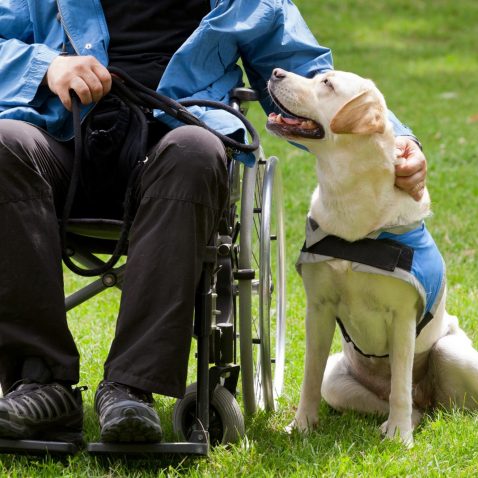
The modern era of service dogs began post World War I when dogs were trained to guide blind war veterans. Since then, dogs have been trained in other specialties, these include;
Diabetes Response Dogs
These dogs sniff the handler’s breath for low blood sugar, can retrieve the phone, and can also carry objects such as juice bottles. Additionally, the dog can prompt the handler to take their insulin. If the dog detects low or high blood pressure, they may react by;
- Jumping the owner
- Sitting and staring at the owner
- Touching the owner on their nose
- Holding a particular toy as a signal
Hearing Dogs
These dogs can alert their handler to doorbells, smoke alarms, alarm clocks, approaching vehicles, and someone calling their handler’s name. For some people, deafness is an isolating disability. Hearings dogs can bring people a new sense of independence and companionship with a loyal companion by their side.
Expert dog trainers spend roughly four months teaching hearing dog puppies. This includes sound work and tailored training to suit the needs of their trainer until they’re around 16 months old.
How do Therapy Dogs Help Humans?
Psychiatric Service Dogs
Psychiatric Service Dogs are used by individuals whose mental impairment is so severe that it affects their ability to perform everyday tasks. For example, a Psychiatric Service Dogs could be trained and assigned to a person with a mental disability who tends to wander off in any direction when disorientated. The dog will be trained to stop them from walking into busy roads.
Dementia Assistance Dogs
Dementia Assistance Dogs are trained to live at home with families where a person has an early-stage diagnosis and lives with a full-time carer. A daily routine is often a secure anchor for families as Dementia progresses. The dog acts as a household reminder and can take some worry off the shoulders of partners and carers.
Community dog visits and dog day events are fun and sociable opportunities for gentle interaction with trained dogs in a dementia-friendly environment. Trained volunteers are at hand and help everybody enjoy the company and comfort that the assistance dog brings.
Guide Dogs
Seeing-eye dogs help those that are blind or visually impaired. These dogs are trained to help navigate around obstacles under the direction of the person that they’re paired with. Guide dogs also provide people with more confidence when carrying out their daily activities.
Medical Alert/Response Dogs
These dogs provide people with the advance notice that they need to take their medication, move somewhere safe, or call for help. Additionally, response dogs can block people from stairways and help them rise to their feet.
Search and Rescue
Search and rescue dogs work in a variety of situations to help find missing people.
Search and Rescue Dogs are usually;
- German Shepherds
- American Labrador Retrievers
- Golden Retrievers
- Bloodhounds
- Border Collies
- Belgian Malinois
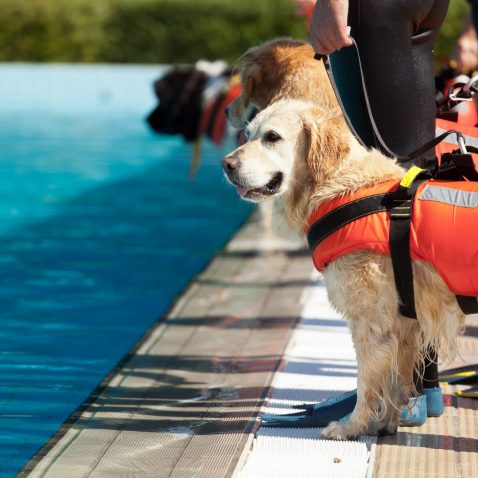
Search and Rescue dogs work in a variety of situations including locating people after a natural disaster, tracking through a natural disaster, cadaver search dogs, and rescue and/recovery situations.
The role of a search and rescue dog handler is serious and requires lots of training which includes finding people by various means such as trailing, tracking, and air scenting. These are efficient methods of quickly searching large areas and don’t always require items of clothing from the missing person.
In the wilderness, air scenting dogs can be deployed to areas from the subject’s last known point or the site of a discovered clues. These dogs are capable of working for 4-8 hours without distraction.
Disaster Dogs
These dogs are known to locate victims of catastrophic or mass-casualty events such as earthquakes, landslides, building collapses and aviation incidents. Disaster dogs rely primarily on air scent.
Avalanche Dogs
Avalanche Dogs work similarly to air scenting, disaster, or cavader dogs by being able to rapidly transition from a wilderness air scenting scenario to a disaster situation, pinpointing the subject’s location.
In mountain areas, provision is made for handlers and dogs to be deployed by aircraft to cut down on the walk times. Similarly, in lowland areas, 4×4 vehicles are used for the same purpose.
Autisim Assist Dogs
Autism Assist Dogs can be the best friend of an autistic child.
These dogs are trained to provide safety, peace of mind and a calming influence for children suffering from autism.

Autism Assist Dogs offer a unique type of intervention and are capable of improving the lives of children with Autism in an unpredictable way. For example, a child that protests against holding their parent’s hand in a busy parking lot would be happy to hold the leash of a dog.
As the dog follows the parent’s commands, the child will follow unquestionably. Also, upon command, these dogs can be sent to interrupt repetitive behavior or to recall a child from space out.
Autism dogs can also be useful for autistic adults. An autistic person often needs to decipher between major and minor stimuli. For example, extra consideration will be applied to a car driving past outside, the sound of crickets and the smell of fabric softener on their clothes to determine which, if any, need their attention.
Autism dogs use commands to “ground” their owners by sitting on their feet to apply pressure when they’re anxious.
This is how service dogs are trained to react to certain behaviors;
- Self-harming – will interrupt the behavior
- Poor motor control – counterbalance, brace for stability
- Auditory scene analysis – Alert to important sounds
- Disorientation – Find the car, go home, find another specified place
- Overstimulation – Deep pressure tasks such as stepping on their foot, putting paws on their lap
How do Police Dogs help Humans?
Police dogs are specifically bred to perform the complicated tasks that are required of them.
This isn’t something that all dogs can do, the following breeds are popular choices to be trained as police dogs;
- Belgian Malinois
- Bloodhounds
- Dutch Shepherds
- German Shepherd Dogs
- Labrador Retrievers
These breeds are known for their incredible athletic ability and willingness to cooperate with their handlers.

Police dogs are trained to bite dangerous suspects and hold them hostage. In most situations, these dogs are first to put their lives on the line and go after an armed suspect to protect their human entourage.
Apprehension dogs are usually herding breeds. Throughout history, herding breeds have been bred to have the physical strength and intelligence to herd livestock. These qualities are necessary when restraining a dangerous person. It’s important that these dogs are stable and have the ability to determine when somebody is a threat. They must also only act on the command of their owners.
Did you know that dogs have 225 million scent receptors in their noses? These receptors come in handy when fighting crime!
When it comes to criminal activity, dogs are taught to detect various explosives, drugs, accelerants, and other crime scene evidence. These dogs are able to perform their tasks anywhere and are most commonly found in airports and border entries.
Military dogs can detect landmines in order to protect their handlers and personnel dangers.
What Dogs are in the Working Group?
Dogs of the Working Group are strong, alert, watchful and intelligent.
These dogs are bred to assist people and excel at tasks such as pulling sleds, guarding property and performing water rescues.
These dogs make wonderful companions but due to their size and naturally protective personalities, potential owners must know how to properly train and socialize a dog. Some breeds in the Working Group are not suitable for first-time owners.

The Working Dog Breeds were bred to fulfill specific tasks.
Here is what some of them were bred to do;
Alaskan Malamute
This breed is one of the oldest sledge breeds of the Arctic. The Alaskan Malamute was created to work in packs to haul heavy loads at low speeds over long distances. This affectionate and loyal dog was named after the native Inuit tribe, Mahlemut, from northwestern Alaska.
Anatolian Shepherd Dog
Before World War II, the United States’ Department of Agriculture imported a breeding pair from Turkey in a secret project. Anatolian Shepherds intimidate their predators rather than fighting them. They’re still active ranch dogs today and protect everything from sheep to ostriches.
Black Russian Terrier
These dogs are known for their courage, intelligence, and confidence. A team of scientists and breeders worked together near Moscow in the 1930s to produce this tireless “fence” dog. These dogs were trained to help control Russia’s borders and hold down prisoners at Stalin’s prison camps.
German Pinscher
This is one of the oldest breeds and is excellent at seizing and nipping. Due to their intelligence and courage, German Pinschers make excellent watchdogs and vigilantly guard their families.
Giant Schnauzer
This dog was developed in the Bavarian Alps in the mid-1800s. They drove cattle from farm to market and were useful guard dogs for farmers, merchants, and innkeepers.
Siberian Husky
The graceful Siberian Husky was capable of hauling light loads over vast expanses of frozen wasteland in freezing temperatures. The breed made headlines in 1925, when Huskies rushed a lifesaving serum to Nome, Ala to combat the Diptheria epidemic. They traveled 658 miles in only five-and-a-half days.
Summary
Don’t worry if you don’t have the money, time or stamina to own a dog full-time, there are still other ways that you can experience the health benefits of being around pets.
Some rescue groups and animal shelters offer rental programs. Dogs that are available for adoption can be rented out for playdates or walks. Alternatively, you can foster a dog temporarily until their permanent home is found.
Also, some organizations offer specially trained therapy dogs to visit children’s hospitals, nursing homes, hospices, schools, shelters and assisted living facilities. During these visits, people are invited to pet the animals which can improve mood and reduce anxiety.
Share the Love
If you found this post useful, please let others know about it by sharing it.
